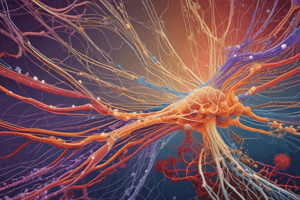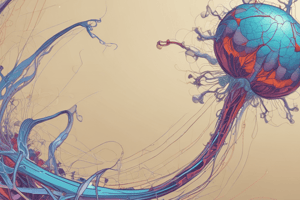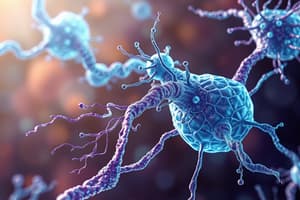Podcast
Questions and Answers
What is the role of cytoskeletal dynamics during cell division?
What is the role of cytoskeletal dynamics during cell division?
Cytoskeletal dynamics play a critical role in forming mitotic spindles that segregate chromosomes during cell division.
What role do migrating fibroblasts play in wound healing?
What role do migrating fibroblasts play in wound healing?
important role
How does Taxol (Paclitaxel) affect microtubules in cell division?
How does Taxol (Paclitaxel) affect microtubules in cell division?
Taxol binds to and stabilizes microtubules, preventing their dynamic rearrangement, ultimately inducing mitotic arrest and potentially leading to cell death.
What do fibroblasts attach to in the ECM via formation of nascent focal adhesions?
What do fibroblasts attach to in the ECM via formation of nascent focal adhesions?
Protrusions are stabilized by the formation of new focal adhesions to the ECM.
Protrusions are stabilized by the formation of new focal adhesions to the ECM.
What are the key functions of microtubules in cells?
What are the key functions of microtubules in cells?
Cytoskeletal components can change rapidly in response to cell needs.
Cytoskeletal components can change rapidly in response to cell needs.
Cell migration involves rapid dynamic cycles of focal adhesion assembly and ___________.
Cell migration involves rapid dynamic cycles of focal adhesion assembly and ___________.
In what way do cancer epithelial cells establish new colonies in new tissues?
In what way do cancer epithelial cells establish new colonies in new tissues?
Flashcards are hidden until you start studying
Study Notes
Cytoskeletal Dynamics in Cell Division and Migration
Case Study: Cytoskeleton and Cancer
- Helena, a 45-year-old woman, diagnosed with breast cancer, is treated with the chemotherapy drug Paclitaxel (Taxol)
- Paclitaxel is used to treat ovarian, breast, and lung cancer, preventing early recurrence and killing dividing cells
The Cell Cytoskeleton
- Can be stable/static or dynamic, reorganizing according to signals received by the cell
- Provides a cell with shape, structure, robustness, polarity, and other important functions in many cellular processes
Key Functions of Cytoskeletal Components
- Microtubules:
- Determine the positions of membrane-bound organelles
- Direct intracellular transport
- Form the mitotic spindle that segregates chromosomes during cell division
- Microfilaments (actin filaments):
- Determine the shape of the cell surface
- Required for whole-cell locomotion (migration)
- Drive the pinching of one cell into two (cytokinesis)
- Intermediate Filaments:
- Provide mechanical strength
Microtubules: General Organisation
- Assemble from heterodimers of α- and β-tubulin
- Polymers of tubulin form long, straight, hollow tubes
- Required for many cellular processes, including cell shape changes, division, and motility, transport of molecules, and organelle positioning
Microtubule Dynamics
- Alternating shrinkage and growth of individual microtubules
- Microtubules switch between phases of growth and shrinkage due to dynamic instability
- Many factors can influence microtubule dynamics, including MAPs, tubulin modifications, temperature, and drugs
Microtubule-Associated Proteins (MAPs)
- Regulate dynamic turnover of microtubules
- Many promote microtubule polymerization and stability
- Some protect microtubules from depolymerization, while others make microtubules less stable or prevent their assembly
Centrosome: The Microtubule Organising Centre
- In vertebrate cells, microtubules grow out from the centrosome
- Consists of a pair of centrioles surrounded by a matrix of pericentriolar material that promotes microtubule growth
- MTOC generates a polarized array of microtubules with minus ends at the cell center and plus ends facing the cell periphery
Cytoskeletal Dynamics during Mitotic Division
- Centrosomes undergo duplication process during interphase, resulting in two closely associated centriole pairs
- Replicated centrosomes move apart prior to nuclear envelope breakdown
- As the nuclear envelope breaks down, bipolar mitotic spindles assemble between the two centrosomes
- Centrosome-nucleated microtubules interact with the chromosomes via kinetochores
Critical Role of Microtubule Dynamics during Mitosis
- M = spindle checkpoint (see lecture 2 on cell cycle checkpoints)
- The natural compound, Taxol, binds to and stabilizes microtubules, preventing the dynamic rearrangement of microtubules, and inducing mitotic arrest
The Actin Cytoskeleton
- Globular actin monomers (G-actin) assemble to form two-stranded helical polymer filaments (F-actin)
- Dispersed throughout the cell (actin stress fibers) and concentrated at the inner face of the plasma membrane (cortical actin)
- Can be reorganized into other structures, such as filopodia, lamellipodia, during cell migration
Actin Treadmilling
- Intrinsic structural polarity and ATP hydrolysis linked to polymerization allow actin filaments to undergo treadmilling by assembling subunits at the barbed (+) end and releasing subunits from the pointed (-) end
The Importance of the Actin Cytoskeleton
- Many natural toxins, such as fungal metabolites, bind to F-actin
- Phalloidins from Amanita phalloides bind to F-actin and prevent its depolymerization, killing human liver cells
- Cytochalasins from molds bind at the growing (+) end and prevent F-actin polymerization, promoting net F-actin disassembly
Cell Migration
- Epithelial cancer cells detach from the ECM, acquire a motile, migrating phenotype, and promote tissue invasion and metastasis
- Complex processes involving localized adhesion and detachment events are involved in cell migration
- Examples of migrating cells include fibroblasts, neutrophils, and metastatic cancer cells
Cell Adhesion and Migration Steps
-
- ADHESION: Cells adhere to ECM via formation of nascent focal adhesions
-
- CELLS EXTEND PROTRUSIONS: Cells extend reorganized actin structures called lamellipodia and filopodia at the leading cell edge
-
- PROTRUSIONS STABILISED BY FORMATION OF NEW FOCAL ADHESIONS TO THE ECM: Involves actin remodelling and many regulatory factors
-
- CELL PULLS ON PROTRUSION: The cell body is moved forward by contraction of the actin cytoskeleton
-
- CELL DETACHMENT AT THE REAR OF THE CELL: Forward cell movement is accompanied by focal adhesion disassembly and cell-substrate detachment at the rear of the cell
Overview: Cell Migration
- Driven by dynamic actin cytoskeleton remodelling
- Assisted by microtubule cytoskeleton
- Involves rapid dynamic cycles of focal adhesion assembly and disassembly
Studying That Suits You
Use AI to generate personalized quizzes and flashcards to suit your learning preferences.



